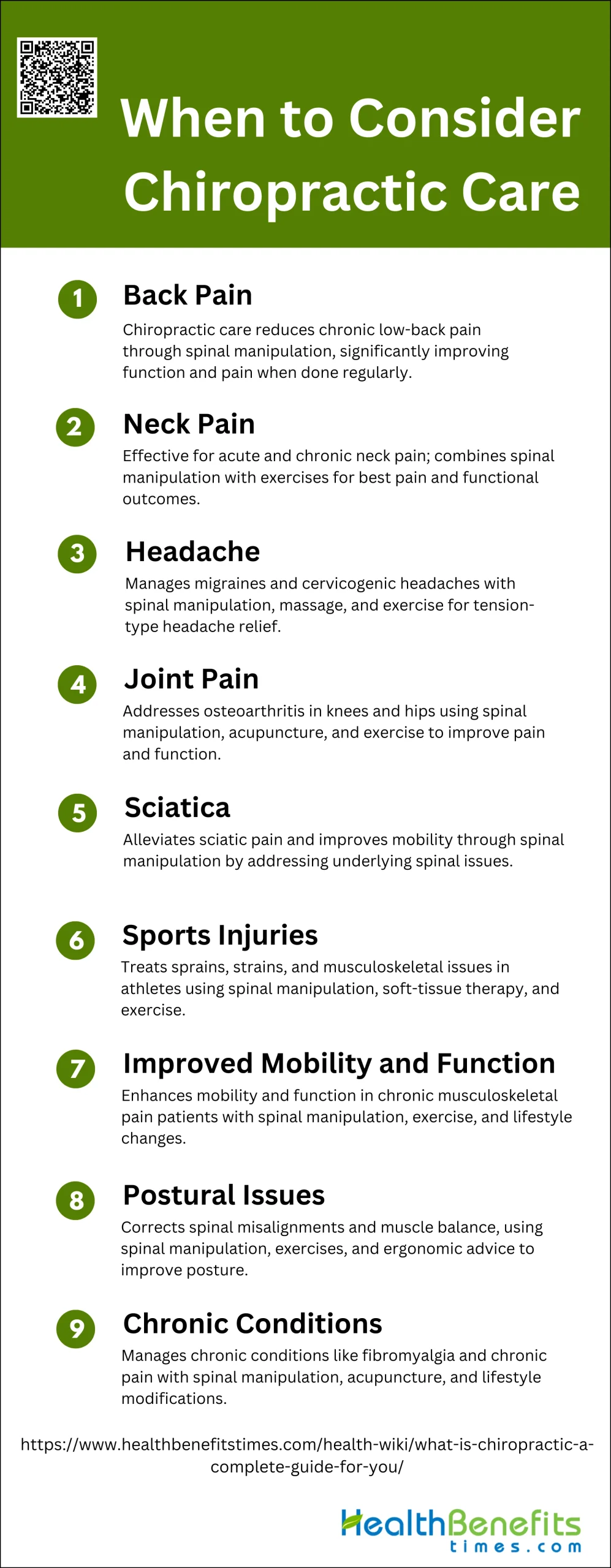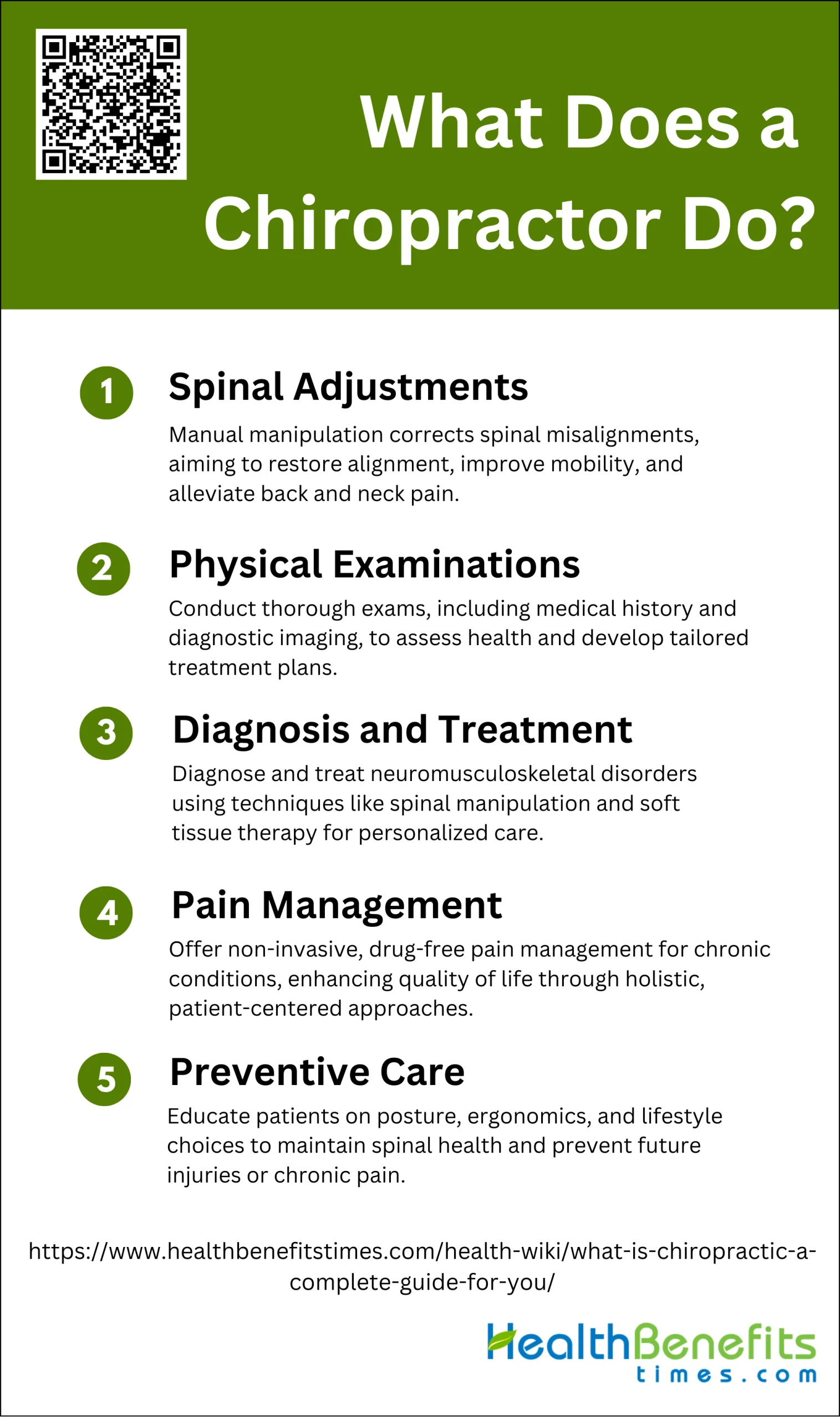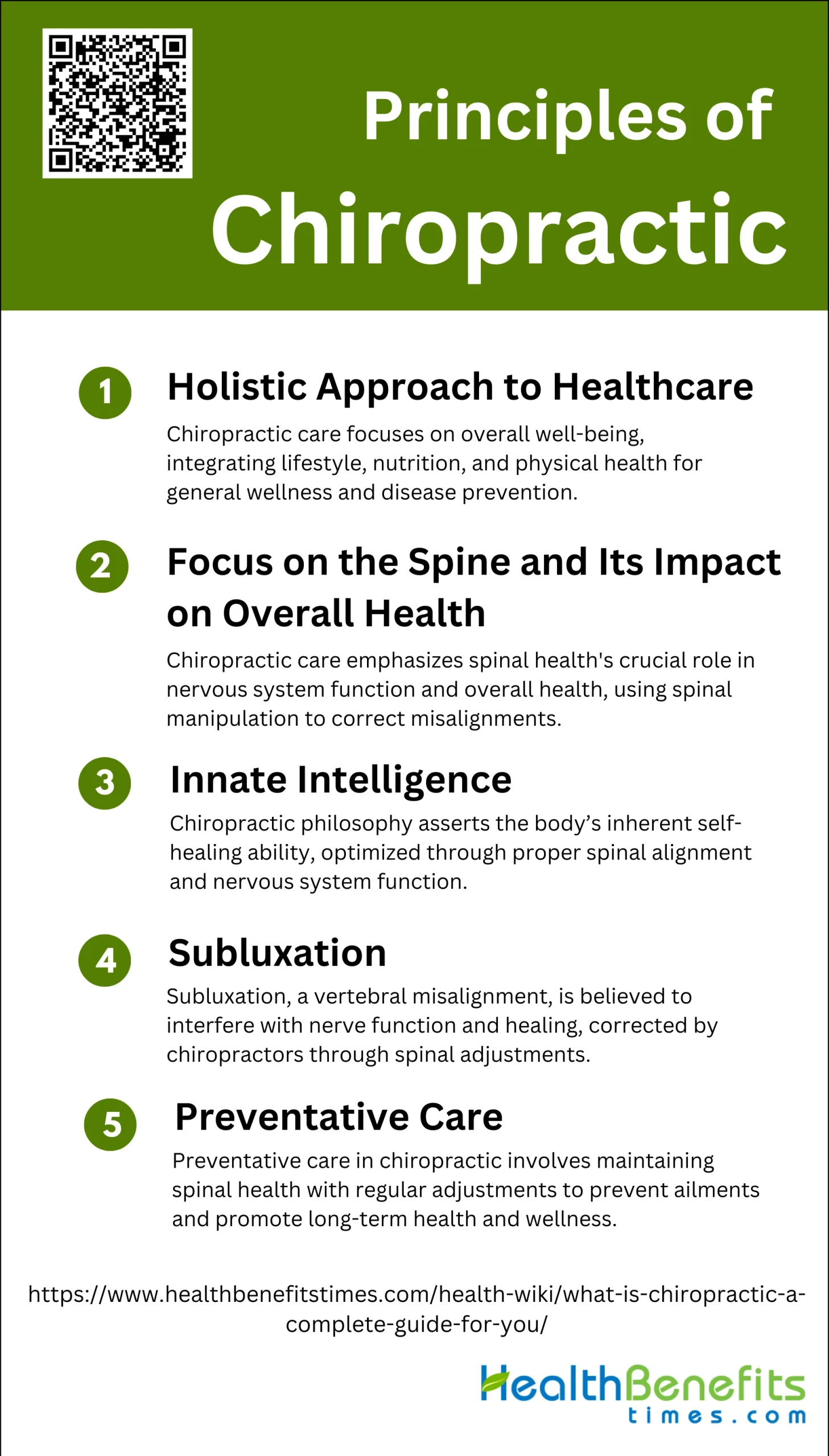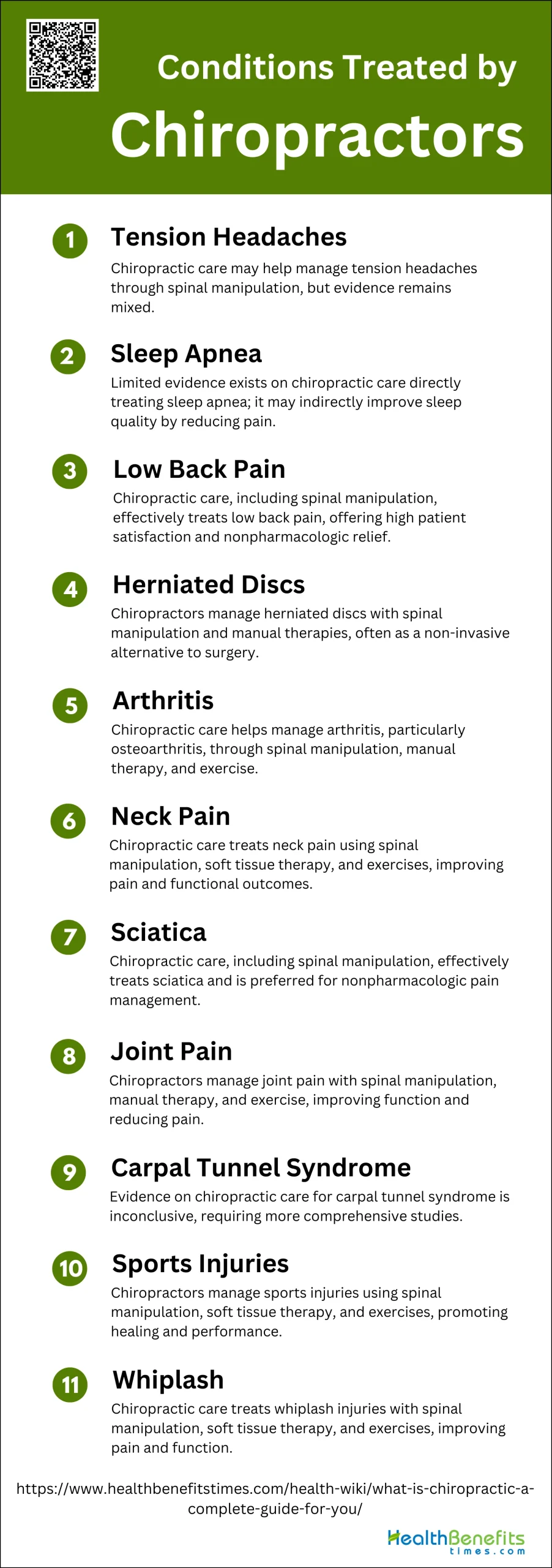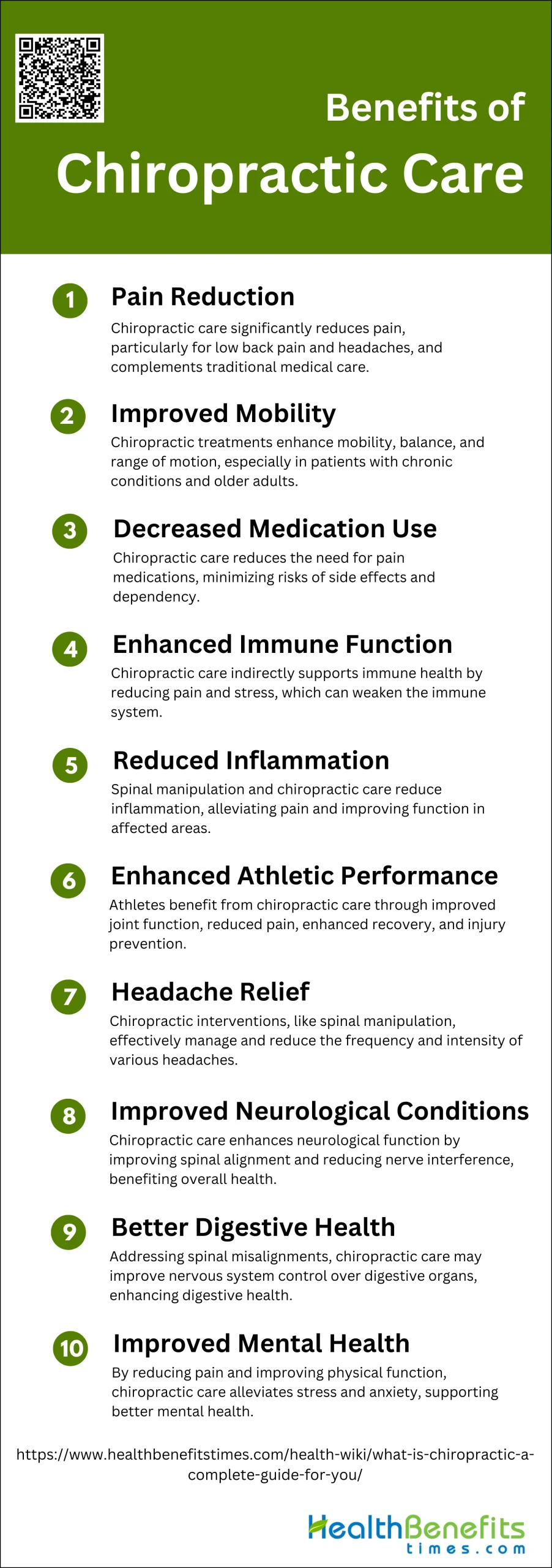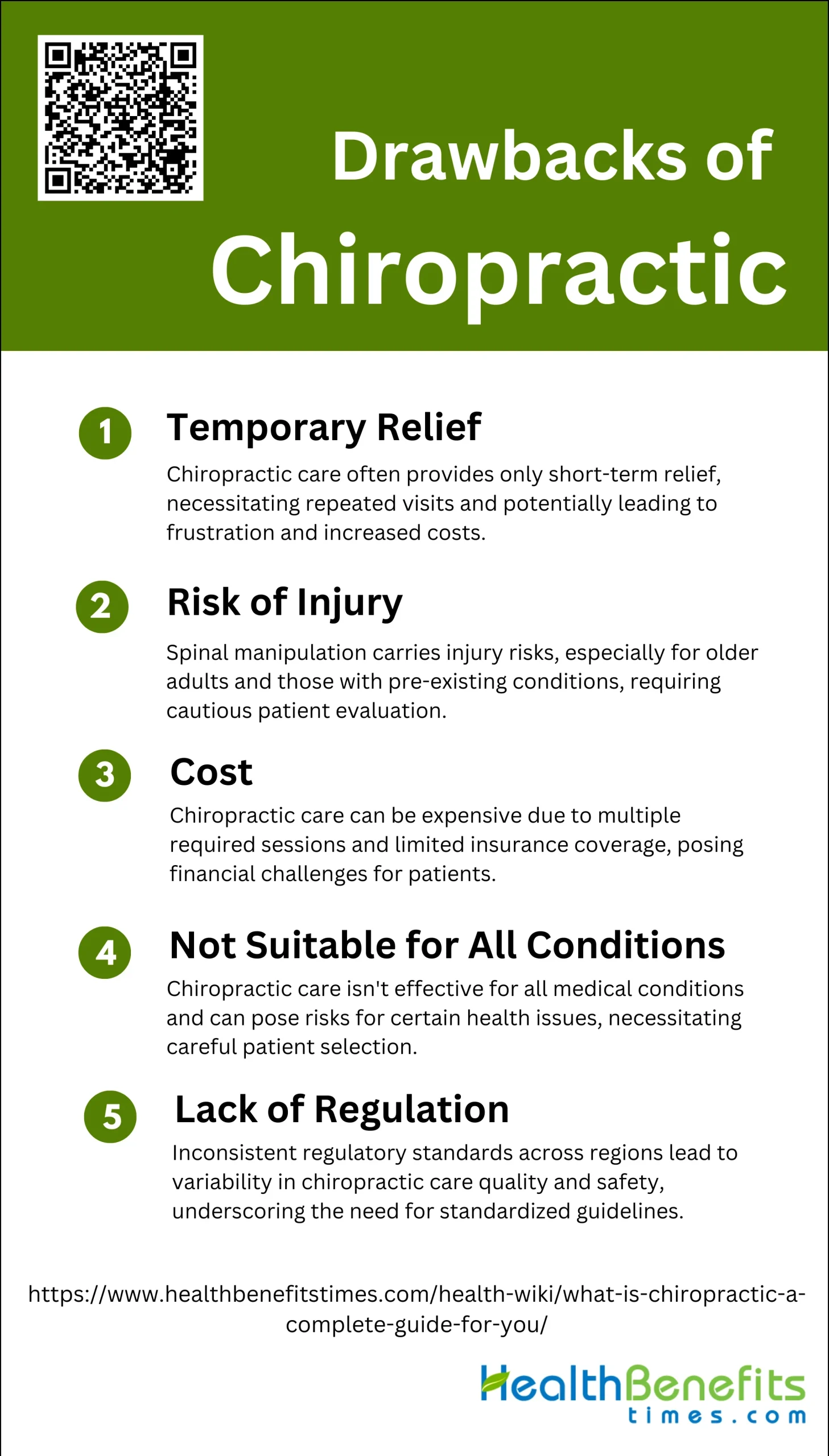 Chiropractic is a healthcare discipline that focuses on diagnosing, treating, and preventing mechanical disorders of the musculoskeletal system, particularly the spine, under the belief that these disorders affect general health via the nervous system. Chiropractors primarily use manual therapies, including spinal manipulation and other joint and soft-tissue adjustments, to alleviate pain and improve function. The practice is grounded in the concept that proper alignment of the body’s musculoskeletal structure, particularly the spine, enables the body to heal itself without surgery or medication. Chiropractic care is often sought for conditions such as back pain, neck pain, and headaches, and it emphasizes a holistic approach to health, incorporating lifestyle advice and physical rehabilitation.
Chiropractic is a healthcare discipline that focuses on diagnosing, treating, and preventing mechanical disorders of the musculoskeletal system, particularly the spine, under the belief that these disorders affect general health via the nervous system. Chiropractors primarily use manual therapies, including spinal manipulation and other joint and soft-tissue adjustments, to alleviate pain and improve function. The practice is grounded in the concept that proper alignment of the body’s musculoskeletal structure, particularly the spine, enables the body to heal itself without surgery or medication. Chiropractic care is often sought for conditions such as back pain, neck pain, and headaches, and it emphasizes a holistic approach to health, incorporating lifestyle advice and physical rehabilitation.
Brief history of chiropractic care
Chiropractic care, founded by D.D. Palmer in 1895, has evolved significantly over the past century to become the second largest healing profession in the United States, following medical doctors, and the most widespread drugless therapy globally. Initially rooted in the belief that spinal adjustments could cure various ailments, chiropractic has faced internal conflicts, particularly between the “straights,” who adhere strictly to Palmer’s original teachings, and the “mixers,” who incorporate other treatments. Despite these internal schisms and external opposition from conventional medicine, chiropractic has maintained a unified profession committed to clinical care. The early years saw the establishment of chiropractic education and practice, notably through the Palmer School of Chiropractic, which played a crucial role in spreading chiropractic care internationally, including to Australia and New Zealand. Over the decades, chiropractic has expanded its scope, with practitioners now addressing a range of musculoskeletal issues, primarily back and neck pain, through spinal manipulation and other therapies. The profession has also developed specialized fields, such as chiropractic orthopedics, to enhance its clinical and research capabilities.
When to consider chiropractic care
Chiropractic care can be a beneficial treatment option for various health issues, particularly those related to the musculoskeletal system. It focuses on diagnosing and treating mechanical disorders of the spine and other joints. Here are some situations when you might consider chiropractic care:
1. Back Pain
Chiropractic care is effective for managing chronic low-back pain (CLBP). Studies show that spinal manipulation and other manual therapies can significantly reduce pain and improve function in patients with CLBP. Regular chiropractic visits, especially more than once per week, are associated with better outcomes.
2. Neck Pain
Chiropractic interventions, including spinal manipulation and multimodal care, are recommended for both acute and chronic neck pain. These treatments have been shown to improve pain and functional outcomes significantly. Combining manipulation with exercises and other therapies yields the best results.
3. Headache
Chiropractic care is beneficial for managing migraines and cervicogenic headaches. For tension-type headaches, low-load craniocervical mobilization may be effective. Multimodal approaches, including massage and exercise, are also recommended for headache management.
4. Joint Pain
Chiropractic care can effectively manage joint pain, including osteoarthritis of the knee and hip. Nonpharmacological treatments such as spinal manipulation, acupuncture, and exercise are recommended. These interventions can improve pain and function, making chiropractic care a viable option for joint pain management.
5. Sciatica
Chiropractic spinal manipulation is a safe and effective treatment for sciatica. It can help alleviate pain and improve mobility by addressing the underlying spinal issues contributing to sciatic nerve irritation. Regular chiropractic care can provide significant relief for patients suffering from sciatica.
6. Sports Injuries
Chiropractic care is beneficial for managing sports injuries, including sprains, strains, and other musculoskeletal issues. Techniques such as spinal manipulation, soft-tissue therapy, and exercise can help athletes recover faster and improve their performance by enhancing mobility and reducing pain.
7. Improved Mobility and Function
Chiropractic care can significantly improve mobility and function in patients with chronic musculoskeletal pain. Treatments such as spinal manipulation, exercise, and lifestyle modifications can enhance overall physical function and quality of life, making chiropractic care a valuable option for improving mobility.
8. Postural Issues
Chiropractic care can address postural issues by correcting spinal misalignments and improving muscle balance. Techniques such as spinal manipulation, exercises, and ergonomic advice can help patients achieve better posture, reducing pain and preventing further musculoskeletal problems.
9. Chronic Conditions
Chiropractic care is effective for managing various chronic conditions, including fibromyalgia and chronic musculoskeletal pain. Nonpharmacological treatments such as spinal manipulation, acupuncture, and lifestyle modifications can provide significant relief and improve patient outcomes.
What does a chiropractor do?
A chiropractor is a healthcare professional who specializes in diagnosing and treating neuromuscular disorders, primarily through manual adjustment and manipulation of the spine. Here’s a detailed overview of what a chiropractor does:
1. Spinal Adjustments
Chiropractors primarily focus on spinal adjustments, which involve the manual manipulation of the spine to correct misalignments, known as subluxations. This practice is rooted in the belief that spinal health is crucial for overall well-being. Spinal adjustments aim to restore proper alignment, improve mobility, and alleviate pain, particularly in the back and neck. Despite its widespread use, the efficacy of spinal manipulation for conditions other than back pain remains controversial, with some studies indicating limited scientific support for its broader therapeutic claims. Nonetheless, spinal adjustments are a cornerstone of chiropractic care, especially for musculoskeletal issues.
2. Physical Examinations
Chiropractors conduct thorough physical examinations to assess a patient’s overall health and identify any neuromusculoskeletal issues. These examinations often include a review of the patient’s medical history, physical assessments, and sometimes diagnostic imaging like X-rays. The goal is to diagnose conditions accurately and develop a tailored treatment plan. Chiropractors are trained to recognize signs that may require referral to other healthcare professionals, ensuring comprehensive patient care. This holistic approach allows chiropractors to address not only the symptoms but also the underlying causes of discomfort.
3. Diagnosis and Treatment
Chiropractors diagnose and treat a variety of conditions, primarily focusing on neuromusculoskeletal disorders. They use a range of techniques, including spinal manipulation, soft tissue therapy, and physiotherapeutic modalities, to manage and alleviate pain. The treatment plans are often personalized, taking into account the patient’s specific needs and health status. While chiropractic care is most commonly associated with back and neck pain, some chiropractors also address other health issues, although the scientific support for these broader applications is limited. Effective diagnosis and treatment are essential for improving patient outcomes and quality of life.
4. Pain Management
Chiropractors play a significant role in pain management, offering non-invasive and drug-free treatment options. This is particularly beneficial for patients with chronic pain conditions, such as that undergoing cancer treatment. Chiropractic care can help reduce pain, improve function, and enhance the quality of life through techniques like spinal manipulation, soft tissue therapy, and ergonomic counseling. The holistic and patient-centered approach of chiropractors makes them valuable members of pain management teams, providing complementary care that can reduce the reliance on pharmaceuticals.
5. Preventive Care
Preventive care is a key aspect of chiropractic practice, focusing on maintaining spinal health and preventing future injuries. Chiropractors educate patients on proper posture, ergonomics, and lifestyle choices that promote overall well-being. By addressing potential issues before they become serious problems, chiropractors help patients avoid chronic pain and other health complications. This proactive approach is particularly important for aging populations, where preventive measures can significantly improve quality of life and reduce healthcare costs. Through regular check-ups and personalized advice, chiropractors support long-term health and wellness.
Principles of Chiropractic
Chiropractic care is grounded in several core principles that guide its practice and philosophy. These principles emphasize the body’s inherent ability to heal itself, the importance of the spine and nervous system in overall health, and the holistic approach to patient care. Below are the key principles of chiropractic:
1. Holistic approach to healthcare
Chiropractic care emphasizes a holistic approach to healthcare, focusing on the overall well-being of the patient rather than just treating specific symptoms. This approach integrates lifestyle, nutrition, and physical health to promote general wellness and prevent disease. Chiropractors often advocate for a drug-free, natural approach to health, emphasizing the body’s innate ability to heal it-self.
2. Focus on the spine and its impact on overall health
Chiropractic care primarily focuses on the spine and its impact on overall health. The central tenet is that spinal health is crucial for the proper functioning of the nervous system, which in turn affects the entire body. Spinal manipulation is used to correct misalignments, known as subluxations, which are believed to interfere with nerve function and overall health.
3. Innate Intelligence
The concept of Innate Intelligence is fundamental in chiropractic philosophy. It posits that the body possesses an inherent ability to heal and regulate itself, which can be optimized through proper spinal alignment and nervous system function. This principle underscores the chiropractic belief in the body’s natural healing capabilities without the need for drugs or surgery.
4. Subluxation
Subluxation refers to a misalignment of the vertebrae that is believed to cause interference with nerve function and impede the body’s natural healing processes. Chiropractors aim to correct these subluxations through spinal adjustments, thereby restoring proper nerve function and promoting overall health. However, the scientific basis for subluxation remains controversial within the medical community.
5. Preventative Care
Preventative care is a key component of chiropractic practice, focusing on maintaining spinal health to prevent future health issues. Regular chiropractic adjustments are believed to help maintain optimal nervous system function, thereby preventing the onset of various ailments and promoting long-term health. This approach aligns with the broader holistic philosophy of chiropractic care, emphasizing wellness and disease prevention.
Chiropractic Techniques
Chiropractic techniques are various methods used by chiropractors to adjust and manipulate the spine and other parts of the body to relieve pain, improve function, and support the body’s natural ability to heal it. Here are some common chiropractic techniques:
1. Activator Method
The Activator Method is a chiropractic technique that employs a small handheld device known as the Activator Adjustment Instrument (AAI) to deliver a controlled, low-force impulse to the spine or extremities. This method is often used to treat conditions such as Chronic Ankle Instability Syndrome (CAIS) and has shown significant improvements in both objective and subjective measures, although it did not outperform manual manipulation techniques in clinical trials2. The Activator Method is particularly favored by more experienced chiropractors and is frequently used in cases involving neurological symptoms.
2. Diversified Technique
The Diversified Technique is the most commonly used chiropractic manipulative therapy for treating spinal musculoskeletal conditions. It involves a variety of manual adjustment techniques aimed at restoring proper movement and alignment of the spine and extremities. This technique is often the first choice for many conditions, although its usage decreases in cases involving neurological symptoms, where methods like the Activator or Flexion-Distraction techniques are preferred. Despite its widespread use, the efficacy of the Diversified Technique compared to other methods remains a subject of ongoing research.
3. Flexion-Distraction
Flexion-Distraction is a chiropractic technique primarily used to treat lumbar disc syndromes with radiculopathy and lumbar central stenosis. This method involves the use of a specialized table that gently distracts and flexes the spine, aiming to relieve pressure on spinal nerves and discs. It is almost as commonly used as the Diversified Technique for certain lumbar conditions and is particularly effective in managing pain and improving spinal function. The technique is often combined with other ancillary procedures like soft tissue therapy and exercise prescription to enhance treatment outcomes.
4. Thompson Technique
The Thompson Technique utilizes a specialized table with drop pieces that facilitate the delivery of high-velocity, low-amplitude adjustments. This method aims to reduce the force required for spinal adjustments, making it a gentler option for patients. While the Thompson Technique is less commonly discussed in the literature compared to methods like Diversified or Activator, it remains a valuable tool in the chiropractor’s arsenal, particularly for patients who may be sensitive to more forceful manipulations. Further research is needed to fully understand its efficacy and optimal applications.
5. Gonstead Technique
The Gonstead Technique is a comprehensive chiropractic approach that involves detailed analysis of spinal x-rays, precise adjustments, and a focus on restoring normal disc alignment and spinal biomechanics. This method is known for its specificity and thoroughness, often involving a full spine assessment to identify and correct subluxations. While the Gonstead Technique is highly regarded among practitioners, its usage and efficacy compared to other techniques like Diversified or Activator are less frequently documented in the literature. More studies are needed to validate its effectiveness across various conditions.
6. Logan Basic Technique
The Logan Basic Technique is a gentle chiropractic method that focuses on the sacrum and lower spine. It involves light pressure applied to specific points on the sacrum to release tension and improve spinal alignment. This technique is particularly suitable for patients who require a less invasive approach, such as those with acute pain or certain neurological conditions. Although not as widely used as the Diversified or Activator methods, the Logan Basic Technique offers a unique approach to spinal care that warrants further investigation to establish its efficacy and best use cases.
7. Spinal Manipulation
Spinal Manipulation is a broad term encompassing various techniques aimed at improving spinal function and alleviating pain through manual adjustments. Techniques like Diversified, Activator, and Flexion-Distraction all fall under this category. Spinal manipulation is a cornerstone of chiropractic care and is used to treat a wide range of musculoskeletal conditions. The choice of specific technique often depends on the condition being treated, the presence of neurological symptoms, and the chiropractor’s experience and preference. Despite its widespread use, ongoing research is essential to fully understand the comparative efficacy of different spinal manipulation techniques.
8. Drop Technique
The Drop Technique involves the use of a specialized chiropractic table with sections that can be raised and then dropped simultaneously with the application of a thrust. This method aims to reduce the force needed for adjustments, making it a gentler option for patients. The Drop Technique is often used in conjunction with other chiropractic methods to enhance treatment outcomes. While it is less frequently mentioned in the literature compared to techniques like Diversified or Activator, it remains a valuable tool for chiropractors, particularly for patients who may be sensitive to more forceful manipulations. Further research is needed to explore its efficacy and optimal applications.
Conditions Treated by Chiropractors
Chiropractors treat a variety of conditions, primarily focusing on issues related to the musculoskeletal system. Here is some common Conditions Treated by Chiropractors:
1. Tension Headaches
Chiropractic care has shown potential benefits in managing tension headaches, particularly through spinal manipulation and multimodal multidisciplinary interventions. Evidence suggests that low-load craniocervical mobilization may be beneficial for longer-term management of both episodic and chronic tension-type headaches. However, the evidence for spinal manipulation as an isolated intervention remains equivocal. Additionally, a randomized pilot study indicated that a higher frequency of chiropractic visits could lead to substantial pain relief in patients with cervicogenic headaches, which often present with tension-type symptoms.
2. Sleep Apnea
There is limited direct evidence on the effectiveness of chiropractic care for sleep apnea. Chiropractic primarily focuses on neuromusculoskeletal disorders, and while it may indirectly improve sleep quality by alleviating pain and discomfort, specific studies on sleep apnea are lacking. Comprehensive studies are recommended to explore this potential area further.
3. Low Back Pain
Chiropractic care is widely recognized for its effectiveness in treating low back pain (LBP). Systematic reviews and clinical practice guidelines suggest that chiropractic care, including spinal manipulation, is as effective as physical therapy and medical care for non-specific LBP. Patients often report high satisfaction with chiropractic care, and it is considered a viable nonpharmacologic treatment option. Additionally, chiropractic care has been associated with significant improvements in pain severity, functional disability, and overall patient satisfaction.
4. Herniated Discs
Chiropractors often manage patients with herniated discs through spinal manipulation and other manual therapies. While specific studies on herniated discs are limited, chiropractic care is generally recommended for managing associated symptoms like low back pain and sciatica. The non-invasive nature of chiropractic treatment makes it a preferred option for many patients seeking to avoid surgery.
5. Arthritis
Chiropractic care can be beneficial for managing arthritis, particularly osteoarthritis of the knee and hip. Clinical practice guidelines recommend nonpharmacological treatments, including spinal manipulation, manual therapy, and exercise, for managing chronic musculoskeletal pain conditions like arthritis. These conservative treatments aim to improve joint function, reduce pain, and enhance the quality of life.
6. Neck Pain
Chiropractic care is commonly used to treat neck pain, including chronic neck pain and neck pain with associated headaches or dizziness. Chiropractors employ a range of treatments such as spinal manipulation, soft tissue therapy, and rehabilitative exercises. Studies indicate that chiropractic care can lead to significant improvements in pain and functional outcomes for patients with neck pain.
7. Sciatica
Sciatica is frequently treated by chiropractors. Spinal manipulation and other manual therapies are commonly used to alleviate the pain and discomfort associated with sciatica. Studies suggest that chiropractic care can be effective in managing low back-related leg pain, including sciatica, and is often preferred by patients seeking nonpharmacologic treatment options.
8. Joint Pain
Chiropractic care is effective in managing various types of joint pain, including pain in the shoulders, knees, and hips. Chiropractors use a combination of spinal manipulation, manual therapy, and exercise to improve joint function and reduce pain. Clinical practice guidelines support the use of these conservative treatments for managing chronic musculoskeletal pain conditions.
9. Carpal Tunnel Syndrome
The evidence for chiropractic care in treating carpal tunnel syndrome (CTS) is inconclusive. While some studies suggest potential benefits, there is a need for more comprehensive and high-quality clinical trials to establish the effectiveness of chiropractic treatment for CTS. Current reviews indicate that chiropractic care may not be significantly effective for this condition.
10. Sports Injuries
Chiropractic care is widely used for managing sports injuries, including muscle strains, ligament sprains, and joint injuries. Chiropractors employ various techniques such as spinal manipulation, soft tissue therapy, and rehabilitative exercises to promote healing and improve function. Studies have shown that chiropractic care can be beneficial in managing sports-related injuries and enhancing athletic performance.
11. Whiplash
Whiplash injuries, often resulting from car accidents, are commonly treated by chiropractors. Treatment typically includes spinal manipulation, soft tissue therapy, and rehabilitative exercises. Studies indicate that chiropractic care can lead to significant improvements in pain and functional outcomes for patients with whiplash injuries.
Benefits of Chiropractic Care
Chiropractic care offers numerous health benefits that can improve your overall well-being. From pain relief to enhanced mobility, this holistic approach addresses various physical ailments. Here are some key benefits of chiropractic care:
1. Pain Reduction
Chiropractic care has been shown to significantly reduce pain in various conditions, particularly low back pain and headaches. For instance, a study involving military personnel demonstrated that the addition of chiropractic care to usual medical care resulted in greater pain relief compared to usual medical care alone. Another study found that chiropractic adjustments were more effective than muscle relaxants in reducing subacute low back pain. These findings suggest that chiropractic interventions can be a valuable component in pain management strategies.
2. Improved Mobility
Chiropractic care can enhance mobility, particularly in patients with chronic conditions. A study focusing on older adults with impaired balance found that extended chiropractic care improved balance and reduced dizziness, which are critical for maintaining mobility. Additionally, chiropractic treatments that include spinal manipulation and rehabilitative exercises have been shown to improve range of motion and reduce disability in patients with chronic neck pain.
3. Decreased Medication Use
Chiropractic care can lead to a reduction in the use of pain medications. In a study involving military personnel with low back pain, those who received chiropractic care in addition to usual medical care reported lower use of pain medications compared to those who received usual medical care alone. This reduction in medication use can help minimize the risk of side effects and dependency associated with long-term medication use.
4. Enhanced Immune Function
While direct evidence linking chiropractic care to enhanced immune function is limited, the reduction in pain and stress achieved through chiropractic treatments can indirectly support immune health. Chronic pain and stress are known to weaken the immune system, so alleviating these issues through chiropractic care may contribute to better overall immune function.
5. Reduced Inflammation
Chiropractic care, particularly spinal manipulation, has been shown to reduce inflammation. A study on the management of chronic musculoskeletal pain recommended nonpharmacological treatments, including spinal manipulation, for their anti-inflammatory effects. By reducing inflammation, chiropractic care can help alleviate pain and improve function in affected areas.
6. Enhanced Athletic Performance
Athletes can benefit from chiropractic care through improved joint function, reduced pain, and enhanced recovery. Chiropractic treatments, including spinal manipulation and soft tissue therapy, can help maintain optimal physical condition and prevent injuries. Studies have shown that chiropractic care can improve pain and disability outcomes, which are crucial for athletic performance.
7. Headache Relief
Chiropractic care is effective in managing various types of headaches, including migraines and cervicogenic headaches. Evidence suggests that spinal manipulation and other chiropractic interventions can reduce the frequency and intensity of headaches. For example, a study found that chiropractic care significantly reduced headache frequency in patients with chronic tension-type and cervicogenic headaches.
8. Improved Neurological Conditions
Chiropractic care can positively impact neurological conditions by improving spinal alignment and reducing nerve interference. Treatments such as spinal manipulation and rehabilitative exercises can enhance neurological function and alleviate symptoms associated with conditions like chronic neck pain. Improved neurological function can lead to better overall health and quality of life.
9. Better Digestive Health
Chiropractic care may improve digestive health by addressing spinal misalignments that affect the nervous system’s control over digestive organs. While direct evidence is limited, the holistic approach of chiropractic care, which includes lifestyle and dietary advice, can contribute to better digestive function and overall health.
10. Improved Mental Health
Chiropractic care can have a positive impact on mental health by reducing pain and improving physical function, which in turn can alleviate stress and anxiety. Studies have shown that chiropractic treatments can lead to significant improvements in pain and disability, which are often linked to mental health issues. By addressing physical pain and promoting overall well-being, chiropractic care can support better mental health outcomes.
Drawbacks of Chiropractic
Chiropractic care can offer benefits for certain conditions, but it also has some potential drawbacks:
1. Temporary Relief
Chiropractic care often provides only temporary relief for certain conditions, particularly musculoskeletal issues like back and neck pain. While spinal manipulation can alleviate pain and improve mobility, the effects may not be long-lasting, necessitating repeated visits. This short-term relief can be attributed to the nature of the treatment, which primarily addresses symptoms rather than underlying causes. Consequently, patients may experience recurring discomfort and require ongoing chiropractic sessions to maintain relief. This cycle of temporary alleviation without addressing root problems can lead to frustration and increased healthcare costs over time.
2. Risk of Injury
Chiropractic spinal manipulation carries a risk of injury, particularly in vulnerable populations such as older adults. Studies have shown that while the overall risk is relatively low, serious complications can occur, including vertebral artery dissection, spinal cord injury, and fractures. For instance, a case report highlighted a pelvic ring injury following chiropractic manipulation in a patient with pre-existing conditions like quadriplegia and osteopenia. These risks underscore the importance of thorough patient evaluation and caution when considering chiropractic care, especially for individuals with underlying health issues.
3. Cost
The cost of chiropractic care can be a significant drawback, especially when compared to other treatment options. While some studies suggest that chiropractic care may be cost-effective for certain conditions, the need for multiple sessions can quickly add up. Additionally, not all insurance plans cover chiropractic treatments, leaving patients to bear the financial burden. This can be particularly challenging for those with chronic conditions requiring long-term care. The financial implications of ongoing chiropractic visits can deter patients from seeking or continuing treatment, potentially leading to untreated or poorly managed conditions.
4. Not Suitable for All Conditions
Chiropractic care is not suitable for all medical conditions, and its effectiveness varies widely depending on the specific ailment. While it may be beneficial for certain types of musculoskeletal pain, it is not recommended for conditions like fractures, infections, or severe osteoporosis. Moreover, some patients with underlying health issues, such as ankylosing spondylitis or other spinal abnormalities, may be at increased risk of complications from spinal manipulation. This limitation necessitates careful patient selection and thorough medical evaluation to ensure that chiropractic care is appropriate and safe for the individual’s specific health needs.
5. Lack of Regulation
The chiropractic profession faces challenges related to regulation and standardization. Unlike conventional medical fields, chiropractic care lacks uniform regulatory standards across different regions, leading to variability in the quality and safety of care provided. This inconsistency can result in disparities in practitioner training, treatment protocols, and patient outcomes. Additionally, the absence of stringent regulatory oversight can make it difficult for patients to assess the qualifications and competence of chiropractors. This lack of regulation underscores the need for more standardized guidelines and oversight to ensure the safety and efficacy of chiropractic treatments.


